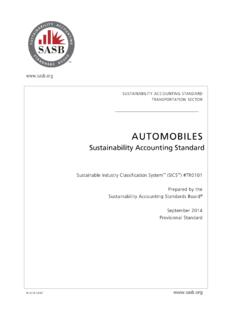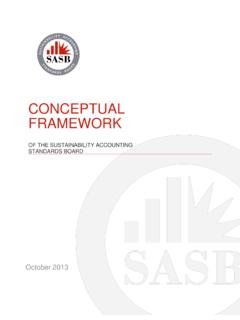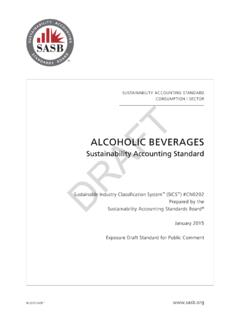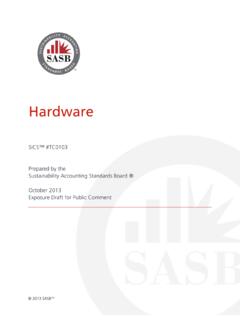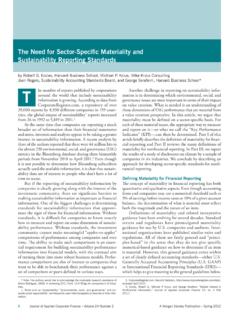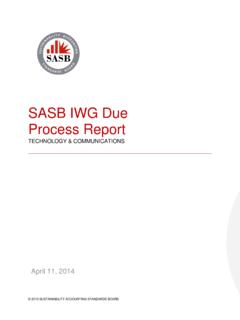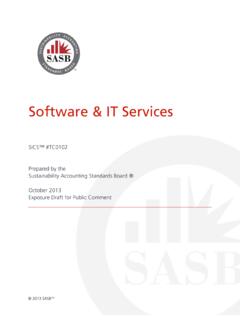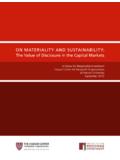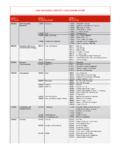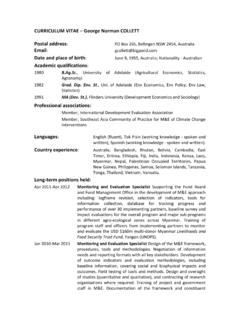Transcription of From Transparency to Performance
1 Industry-Based sustainability Reporting on Key IssuesFrom Transparencyto PerformanceIndustry-Based sustainability Reporting on Key IssuesFrom Transparencyto PerformanceSteve LydenbergJean RogersDavid WoodREPORT AUTHORSS teve Lydenberg, Chief Investment Officer, Domini Social InvestmentsJean Rogers, PhD, Principal, Arup David Wood, PhD, Director, Initiative for Responsible Investment, Harvard University ACKNOWLEDGEMENTSThe authors would like to thank Andrea Fernandez of Arup for her critical role in providing assistance with this report s development, including sector research and significant input to testing the materiality screening approach andtranslation of issues to key Performance indicators. We would also like to acknowledge the review of report drafts and invaluable feedback fromMike Wallace (GRI), Allen White (Corporation 20/20), AdamKanzer (Domini Social Investments), Mike Krzus (Grant Thornton), and Jane Nelson (Kennedy School of Government).
2 Additionally, the authors are grateful for the support and leadership of the Hauser Center and the Initiative for Responsible Investment at Harvard University in promoting the understanding of environmental, social, economic issues in corporate governance and the relationship of disclosure to improved Performance and the advancement of a prosperous and equitable society. DESIGN Tim Pattinson, Arup stock: 80# Reincarnation Matte Book Cover stock: 95# Reincarnation Matte CoverAll stock is 100% recycled, with a 60% post-consumer waste Printed with soy and vegetable-based inks, using wind-powered SummaryMandatory sustainability ReportingIntroductionThe Growth of Voluntary sustainability ReportingThe Need for Mandatory sustainability ReportingUsefulness of Key Performance IndicatorsConvergence with Financial Reporting and Establishing Key Performance IndicatorsRole of Key sustainability Performance IndicatorsA Six-step Method for Identifying Key sustainability Performance Indicators by Industry SectorResults fromtheExperimentConclusion and RecommendationsEndnotes and ResourcesAppendicesTable of Contents1230102040510141618 28343844ivviIIINITIATIVE FOR RESPONSIBLE INVESTMENTList of Figures and TablesFigures1 Six-Step method for developing industry specific key Performance indicators2 Universe of ESG issues and opportunities3 Materiality test4 Establishing the cut-off point for minimum materiality5 Framework
3 For ESG key Performance indicators and management disclosures6 Key Performance indicators and management disclosures:Guidance for airlines subsector7 Material issues across the six subsectors8 KPI s in practice comparable and complete data setA1 Proposed relationship between minimum ESG disclosure requirements and complete disclosure in a company s form 10-KC1 Financial vs. sustainability ReportingD1 sustainability Guidance: Key Performance Indicators for Airlines SubsectorD2 sustainability Guidance: Key Performance Indicators for Automobiles SubsectorD3 sustainability Guidance: Key Performance Indicators for Banks SubsectorD4 sustainability Guidance: Key Performance Indicators for Conventional Electricity Subsector18 19212325272932475962636465 IIIFROM Transparency TO PERFORMANCED5 sustainability Guidance: Key Performance Indicators for Paper SubsectorD6 sustainability Guidance: Key Performance Indicators for Diversified REITs SubsectorE1 Example of Integrated Reporting: sustainability Reporting as part of form 10-K ReportF1US Financial Reporting CycleF2 Example of Integrating ESG Reporting into Financial ReportingG1 Categories Highlighting Subsectors ReviewedTablesA1 GRI vs.
4 Industry-specific KPIsF1 Roles and Responsibilities in the current US Financial Reporting SystemF2 Options for different models to strengthen ESG Reporting66 67 7179 838648 7781 IVINITIATIVE FOR RESPONSIBLE INVESTMENTThe need to set down our thoughts on how a systemof Key Performance Indicators (KPIs) might be developed and integrated into the broader movement to mandate the disclosure of sustainability data grew fromthree convictions. First, we were convinced that improved disclosure of sustainability data in the US is both necessary and needed urgently. Second, we were convinced that it must be mandatory, or at least to some extent. Third, we believed that better guidance could enable companies to be in a stronger position to rise to the challenge of sustainability reporting and see benefits rather than burdens. It is our hope that establishing sustainability KPIs for all sectors will enable companies to move froma compliance driven disclosure mindset to one of managing and even competing on Performance on the sustainability issues that matter most.
5 At the same time, we recognized that it is difficult to determine exactly which of the many facts andfigures that make up the full range of sustainability data crucial information about how corporations affect our daily lives and their implications for generations to come should be disclosed. Many have tried their hand at enumerating those most important sustainability data points. The Global Reporting Initiative is chief among those tackling this task, but the French government s New Economic Regulations of 2001 have set out its own list of 40 key indicators; Dow Jones and FTSE have come up with scoring systems and key indicators in constructing their sustainability stock indexes; and sustainability and AccountAbility have devised systems for determining the most material and comprehensive sustainability thing was clear to us fromthese various and varied initiatives the guidance must be relevant to the core operations of the business, and the sustainability data disclosed as a result must be relevant to key stakeholders in the corporation, including not just the stockowners, but customers, employees, communities, suppliers, and the environment.
6 Transparency in the data these stakeholders want and need is the crucial first step on the road to better Performance , changing corporations actual practice in daily life and making companies more responsive to global challenges and the needs of today s society. ForewordVFROM Transparency TO PERFORMANCED eciding which data points should be disclosed and by whomis critical for the success of this next step in the managing of corporations relations with society. This decision must successfully identify those data points that are most important to the widest array of stakeholders for issues on which change is most needed and most possible in a resource constrained society. The process for making this decision must itself be transparent and trustworthy. The result must be practical and a legitimate process for implementation is the important first step in going down the road to mandatory disclosure.
7 If the process is properly conceived, the most appropriate data points will flow fromit naturally and evolve as needed to address new issues and concerns. For this reason, we have concentrated here on how a process for determining KPIs might be best developed, rather than on determining indicators themselves, although we have used hypothetical case studies to demonstrate how this process might produce specific results. This process provides new insights into how to approach understanding the materiality of sustainability issues, as a prelude to disclosure and management. As such, it is useful not only for regulatory or standards-setting bodies, but for corporations struggling to put processes in place to manage the risks and opportunities associated with material, non-financial issues facing their sector. We recognize that the task at hand is challenging and its implications extend well beyond the financial community.
8 Many regulators, financial professionals, and non-governmental organizations around the world today are tackling this challenge, as countries around the world move toward imposing their specific solutions to this problem. What exactly will be the outcome of this movement toward mandatory sustainability disclosure in the US and beyond may not be entirely clear today, but we hope that the ideas brought forward in this paper can contribute to that important Wood June 2010 Cambridge, MassachusettsJean RogersSteve LydenbergVIINITIATIVE FOR RESPONSIBLE INVESTMENTThis paper proposes a method for identifying key Performance indicators on the sustainability or social and environmental impacts of US corporations inspecific industries. We believe that mandatory reporting by US corporations on their impacts on society and the environment is not only desirable, but inevitable.
9 What specific data needs to be reported and in what form , however, remain challenging questions. We believe that it is crucial to pursue simultaneously both mandatory reporting of sustainability indicators in a standardized format and reporting on key Performance indicators specific to particular work has been done by the Global Reporting Initiative (GRI) on establishing a credible set of universally applicable indicators. More work needs to be done on how to determine relevant sector-specific key Performance indicators as a minimum basis for sustainability reporting. Over 3,000 corporations around the world now engage in sustainability reporting. Historically, sustainability reporting by US corporations lags behind that of their peers in other regions of the world1. As an increasing number of governments and stock exchanges encourage or require sustainability reporting, corporations and financial markets in the United States run the risk of diminishing their competitiveness in sustainability .
10 This data can be crucial in aligning business practices with those of a sustainable economy and in providing a means for benchmarking the Performance of large corporations as they interact with society and the environment. Our method for developing key Performance indicators (KPIs) for sustainability relies on three principles simplicity, materiality, and Transparency . Building on a broad disclosure framework such as that of the Global Reporting Initiative, this method suggests how those sustainability KPIs most material to all stakeholders can be SummaryVIIFROM Transparency TO PERFORMANCEWe believe that this proposed method for establishing KPIs can be useful for, among others: Regulators or stock exchangescontemplating increased targeted requirements for sustainability reporting; Corporations seeking to enhancethe credibility of their sustainability reporting and improve its integration into financial reporting on material factors; Stakeholders seeking to betterunderstand the most important elements of a corporation s sustainability Performance .
